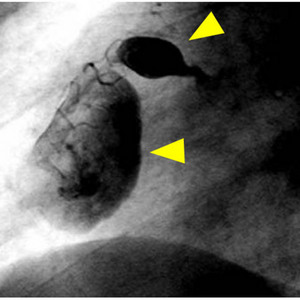Aug. 15, 2008 Research Highlight Biology
Finding the roots of a mysterious disease
A new study pinpoints a specific gene variation linked to a major cause of pediatric acquired heart disease
 Figure 1: Consequences of untreated—or treatment-resistant—Kawasaki disease can include the formation of giant coronary aneurysms.
Figure 1: Consequences of untreated—or treatment-resistant—Kawasaki disease can include the formation of giant coronary aneurysms.
Kawasaki disease (KD) is an inflammatory disorder of the blood vessels, most frequently observed in infants and young children. Left untreated, KD can have severe health consequences (Fig. 1), and it is currently the leading cause of acquired heart disease for children in the developed world.
KD was first discovered by Tomisaku Kawasaki over 40 years ago, yet little is known about its root causes. Some evidence has suggested a microbial origin for KD; more recent findings indicate a genetic basis, however, and geneticist Yoshihiro Onouchi was among the first to closely explore this possibility.
As a student, Onouchi worked with Kawasaki to collect DNA samples from related KD patients in an effort to identify relevant genetic markers. Now, as a researcher at the RIKEN Center for Genomic Medicine in Yokohama, Onouchi has again partnered with Kawasaki and other scientists from Japan and the US to identify the first gene variant linked with KD pathology1.
Since KD is most prevalent in Japan, the researchers began by investigating pairs of affected Japanese siblings. They looked for tiny DNA sequence variations that might be associated with the disease, and identified nine variants that could be potentially linked to KD. By performing a parallel analysis of the inheritance patterns for these variations in Americans of European ancestry—among whom KD is much rarer—the team narrowed the number of candidates down to four.
They became particularly interested in one variation, in the gene encoding the signaling protein ITPKC. Onouchi’s team found that ITPKC appears to play an important role in the suppression of T cell activity—an unexpected role for this protein. The gene variant they identified appears to result in a significant reduction in ITPKC production, leading to an increase in T cell activity that could represent the underlying cause for the inflammatory component of KD pathology. “I think one of our most important findings is the characterization of ITPKC as an immune gene,” says Onouchi.
Subsequent genetic analysis of a cohort of American patients has shown that this ITPKC variant is linked with resistance to standard KD therapies, and the investigators are now looking for similar patterns in Japanese patients. These findings may also lead to new therapeutic approaches. “We will try to validate the effectiveness of the immunosuppressant cyclosporine A as an alternative treatment,” says Onouchi, “as this compound targets the pathway in the T-cells in which ITPKC acts as a negative regulator.”
References
- 1. Onouchi, Y., Gunji, T., Burns, J.C., Shimizu, C., Newburger, J.W., Yashiro, M., Nakamura, Y., Yanagawa, H., Wakui, K., Fukushima, Y. et al. ITPKC functional polymorphism associated with Kawasaki disease susceptibility and formation of coronary artery aneurysms. Nature Genetics 40, 35–42 (2008). doi: 10.1038/ng.2007.59
